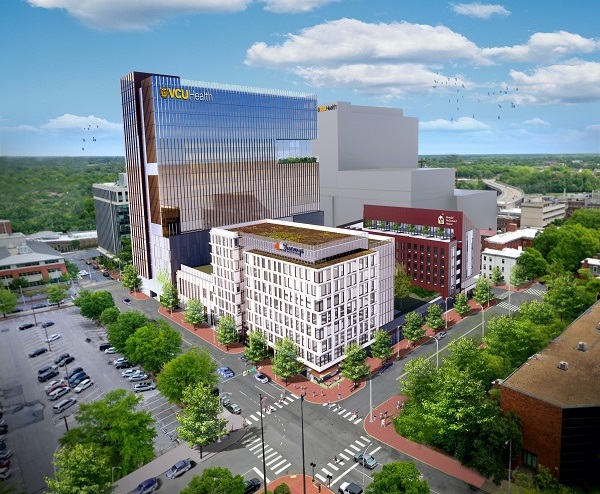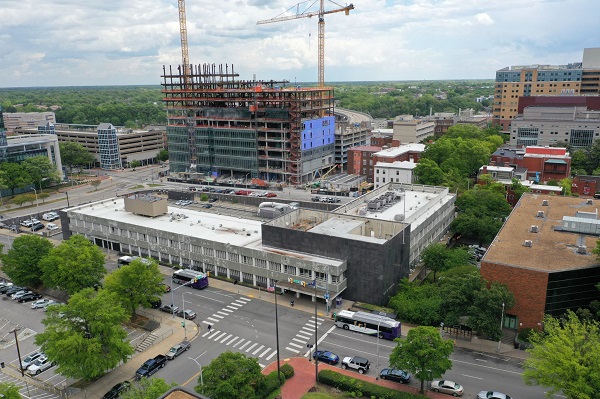
A rendering of the proposed office tower and complex that would replace the Public Safety Building. (BizSense file images)
Nearly a year to the day that a majority of its members voted down the controversial Navy Hill plan, a unanimous Richmond City Council on Monday approved a portion of the project that was decidedly uncontroversial by comparison.
In a specially called meeting, councilmembers adopted three ordinances authorizing the sale of the city’s Public Safety Building property and adopting a development agreement with Capital City Partners, which is planning a 20-story, VCU Health-anchored tower and mixed-use office complex on the bulk of the 3-acre property at 500 N. 10th St.
The $325 million project also would involve a reconnection of East Clay Street between Ninth and 10th streets, for which the council declared a portion of the property as surplus.
Following a public hearing in which numerous speakers voiced support for the project — particularly its involvement of VCU Health and providing new facilities for local nonprofits The Doorways and Ronald McDonald House Charities of Richmond — councilmembers likewise praised the proposal and the efforts of city administrators who negotiated the deal.
Councilmembers also noted anticipated real estate tax revenue from the development, projected to total nearly $60 million over the first 25 years. That’s on top of the negotiated sale price of $3.52 million that likewise would add to the city’s coffers.
The project is a variation of what was known as “Block D” in Navy Hill, a $1.5 billion plan that included replacing The Coliseum and relied in part on tax-incremental financing. A council majority last February voted down that plan, which was designed by the same development team behind CCP.
That team includes Michael Hallmark of Richmond-based Future Cities, and Susan Eastridge of Northern Virginia-based Concord Eastridge. Hallmark and Eastridge, who are also behind the $2.3 billion arena-anchored GreenCity development in Henrico, were represented in their negotiations with the city by local attorney Mark Kronenthal with Roth Jackson Gibbons Condlin.

The Public Safety Building as viewed along Ninth Street last year, with the under-construction VCU Health outpatient building rising behind it.
Per the development agreement, CCP is assuming responsibility for all demolition and public infrastructure costs related to the development and street extension.
Other terms are aimed at providing job training and hiring local construction workers, with CCP required to create a $500,000 fund over five years to support small businesses leasing space in the development, student scholarships, and other forms of community assistance.
Initially proposed last May at $350 million, the slightly scaled-down project calls for over 90,000 square feet of spec Class A office space, reduced from the original plan for a 150,000-square-foot spec space. The number of structured parking spaces also has been reduced from 1,900 to 1,200, with up to 200 of those to be made available for city employees.
The rest of the proposed development remains largely the same, with 150,000 square feet of administrative and office space for VCU Health; a 125,000-square-foot space with 145 guest rooms for The Doorways; a 65,000-square-foot space with 60 guest rooms for Ronald McDonald House; and 20,000 square feet of ground-level retail, including a pharmacy.
The development also would include 35,000 square feet of childcare space for VCU employees, with at least 20 percent of childcare slots made available at the same cost for city residents not employed by the health system or university.
The project would relocate the existing GRTC transfer station on Ninth Street to the surface parking lot across Ninth from the building. Plans also call for at least 40 percent minority business participation during construction and in the building’s operation.

A rendering of the proposed office tower and complex that would replace the Public Safety Building. (BizSense file images)
Nearly a year to the day that a majority of its members voted down the controversial Navy Hill plan, a unanimous Richmond City Council on Monday approved a portion of the project that was decidedly uncontroversial by comparison.
In a specially called meeting, councilmembers adopted three ordinances authorizing the sale of the city’s Public Safety Building property and adopting a development agreement with Capital City Partners, which is planning a 20-story, VCU Health-anchored tower and mixed-use office complex on the bulk of the 3-acre property at 500 N. 10th St.
The $325 million project also would involve a reconnection of East Clay Street between Ninth and 10th streets, for which the council declared a portion of the property as surplus.
Following a public hearing in which numerous speakers voiced support for the project — particularly its involvement of VCU Health and providing new facilities for local nonprofits The Doorways and Ronald McDonald House Charities of Richmond — councilmembers likewise praised the proposal and the efforts of city administrators who negotiated the deal.
Councilmembers also noted anticipated real estate tax revenue from the development, projected to total nearly $60 million over the first 25 years. That’s on top of the negotiated sale price of $3.52 million that likewise would add to the city’s coffers.
The project is a variation of what was known as “Block D” in Navy Hill, a $1.5 billion plan that included replacing The Coliseum and relied in part on tax-incremental financing. A council majority last February voted down that plan, which was designed by the same development team behind CCP.
That team includes Michael Hallmark of Richmond-based Future Cities, and Susan Eastridge of Northern Virginia-based Concord Eastridge. Hallmark and Eastridge, who are also behind the $2.3 billion arena-anchored GreenCity development in Henrico, were represented in their negotiations with the city by local attorney Mark Kronenthal with Roth Jackson Gibbons Condlin.

The Public Safety Building as viewed along Ninth Street last year, with the under-construction VCU Health outpatient building rising behind it.
Per the development agreement, CCP is assuming responsibility for all demolition and public infrastructure costs related to the development and street extension.
Other terms are aimed at providing job training and hiring local construction workers, with CCP required to create a $500,000 fund over five years to support small businesses leasing space in the development, student scholarships, and other forms of community assistance.
Initially proposed last May at $350 million, the slightly scaled-down project calls for over 90,000 square feet of spec Class A office space, reduced from the original plan for a 150,000-square-foot spec space. The number of structured parking spaces also has been reduced from 1,900 to 1,200, with up to 200 of those to be made available for city employees.
The rest of the proposed development remains largely the same, with 150,000 square feet of administrative and office space for VCU Health; a 125,000-square-foot space with 145 guest rooms for The Doorways; a 65,000-square-foot space with 60 guest rooms for Ronald McDonald House; and 20,000 square feet of ground-level retail, including a pharmacy.
The development also would include 35,000 square feet of childcare space for VCU employees, with at least 20 percent of childcare slots made available at the same cost for city residents not employed by the health system or university.
The project would relocate the existing GRTC transfer station on Ninth Street to the surface parking lot across Ninth from the building. Plans also call for at least 40 percent minority business participation during construction and in the building’s operation.
congratulations to the City Council, the developers, and Attorney Mark Kronenthal for pushing this important proposal forward. One eyesore block will be replaced by a beautiful new building. Let’s use that money to scrape the rust bucket of an arena off its block and take proposals for something new to occupy that space.
Yes Bruce. No one has ever made a case as to why a stadium MUST be there, and, indeed, I can think of many reasons why one would be better located somewhere else. People have dreams of Camden Yards, but is it my imagination or was that built in a location that is ADJACENT to everything and not smack in the middle of everything? An important distinction. RIchmond should likely consider a location SOUTH of the James (gasp) for such a project, that or let one of the counties build one, which they would if it made economic sense. The… Read more »
Shawn, your comments come with good intentions but that’s not how arena economics work. Few arena ever makes money, with the exception of major markets like NYC, where it stays rented out by multiple parties. As much as I’d love to see a new arena it just won’t ever make money for a locality here. Having an arena makes sense downtown because people have options to eat and drink afterwards by walking somewhere, whereas an arena like PNC in Raleigh limits the fan’s experience to only concession food/drinks. Arenas now regularly offer better food, mixed drinks, and craft beers, which… Read more »
It’s about time. This is how intelligently run cities do things: Let the private sector determine what is wanted, and let them build it and take the risks. Government doesn’t try to determine the outcome other than put in reasonable restrictions and safeguards and demands no other payoffs other than the increases in tax revenue that reassessment eventually brings. Am I living in a fantasy world? No. It is all a matter of degree — corrupt nations’ governments demand payoffs and try to micromanage everything — and nothing gets built and the little people have nothing. Great nations, it is… Read more »
Now the city can put in 3 to 4 million extra dollars a year into repaving streets and rebuilding it’s decaying sidewalk system. The nice part about this project is it is taking a spot that is already paved over with a low rise building and parking lot and turning into a tax producing piece of land that doesn’t take out more green space.